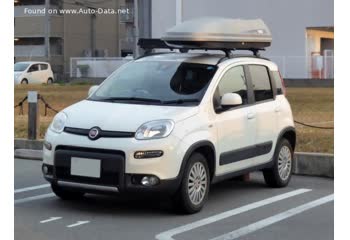Everything you need to know about specifications and performance - Fiat Panda 2020 - 1.0 GSE (70 Hp) Mild Hybrid

Overview:
What is the engine capacity of a Fiat Panda 2020?
The engine capacity of the Fiat Panda 2020 is 999.
Fiat Panda 2020 How many horsepower?
The engine power of the Fiat Panda 2020 is 70 Hp @ 6000 rpm..
What is the Fiat Panda 2020 engine?
Fiat Panda 2020 engine is FireFly / 46341162. (Click to see other cars using the same engine)
How much gasoline does a Fiat Panda 2020 consume?
The Fiat Panda 2020 consumes 4.1 liters of gasoline per 100 km
General:
Brand: Fiat
Model: Panda
Generation: III (319, facelift 2020)
Modification (Engine): 1.0 GSE (70 Hp) Mild Hybrid
Start of production: October, 2020
End of production:
Powertrain Architecture:MHEV (Mild Hybrid Electric Vehicle, power-assist hybrid, battery-assisted hybrid vehicles, BAHV)
Body type:Hatchback
Seats: 4-5
Doors: 5
Engine:
Engine systems: Start & Stop System
Power: 70 hp @ 6000 rpm.
Power per litre: 70.1 hp/l
Torque: 92 nm @ 3500 rpm.
Engine Model/Code:FireFly / 46341162
Engine displacement: 999
Number of cylinders: 3
Engine configuration: Inline
Number of valves per cylinder: 2
Fuel injection system: Multi-port manifold injection
Engine aspiration: Naturally aspirated Engine
Valvetrain: SOHC
Engine oil capacity: 2.5 l
Coolant: 4.4 l
Engine layout: Front, Transverse
Cylinder Bore: 70 mm
Piston Stroke: 86.5 mm
Compression ratio: 12:1
Performance:
Fuel Type: Petrol (Gasoline)
Fuel consumption (economy) - urban: 5.5 l/100 km
Fuel consumption (economy) - extra urban: 3.2 l/100 km
Combined fuel consumption (WLTP): 4.8 l/100 km
Fuel consumption (economy) - combined (NEDC): 4.1 l/100 km
Fuel consumption at Low speed (WLTP): 4.9 l/100 km
Fuel consumption at Medium speed (WLTP): 4.5 l/100 km
Fuel consumption at high speed (WLTP): 4.1 l/100 km
Fuel consumption at very high speed (WLTP): 5.4 l/100 km
Fuel consumption (economy) - urban (NEDC): 5.5 l/100 km
Fuel consumption (economy) - extra urban (NEDC): 3.2 l/100 km
Fuel consumption (economy) - combined: 4.1 l/100 km
Emission standard: Euro 6d
Acceleration 0 - 100 km/h: 13.9 sec
Acceleration 0 - 62 mph: 13.9 sec
Maximum speed: 164 km/h
Weight-to-power ratio: 14 kg/Hp, 71.4 Hp/tonne
Weight-to-torque ratio: 10.7 kg/Nm, 93.9 Nm/tonne
Acceleration 0 - 60 mph: 13.2 sec
Electric system:
Battery technology: Lithium-ion (Li-Ion)
Electric motor power: 5 hp
Electric motor location: Front, Transverse
Battery voltage: 12 V
Space:
Kerb Weight (kg): 980
Max. weight (kg): 1420-1440
Max load (kg): 440-460
Trunk (boot) space - maximum: 870 l
Trunk (boot) space - minimum: 225 l
Fuel tank capacity: 38 l
dimensions:
Length: 3653 mm
Width: 1643 mm
Height: 1551 mm
wheelbase: 2300 mm
Width including mirrors: 1882 mm
Front track: 1409 mm
Rear (Back) track: 1407 mm
Front overhang: 747 mm
Rear overhang: 606 mm
Minimum turning circle (turning diameter): 9.3 m
Powertrain, Suspension and Brakes:
Drivetrain Architecture: The Internal combustion Engine (ICE) and electric motor drive the front wheels of the car with the ability to work only in mixed mode.
Drive wheel: Front wheel drive
Number of gears and type of gearbox: 6 gears, manual transmission
Front brakes: Disc, 257 mm
Rear brakes: Drum, 203 mm
Assisting systems: ABS (Anti-lock braking system)
Steering type: Steering rack and pinion
Power steering: Electric Steering
Tires size: 175/65 R14; 185/55 R15; 195/45 R16
Wheel rims size: 5.5J x 14; 6J x 15; 6.5J x 16
Front suspension: Independent, type McPherson with coil Spring and anti-roll bar
Rear suspension: Transverse stabilizer, Torsion
See also

Other generation.
Its production began in 2004 until 2010

Other generation.
Its production began in 2018 until 2020

Write a comment